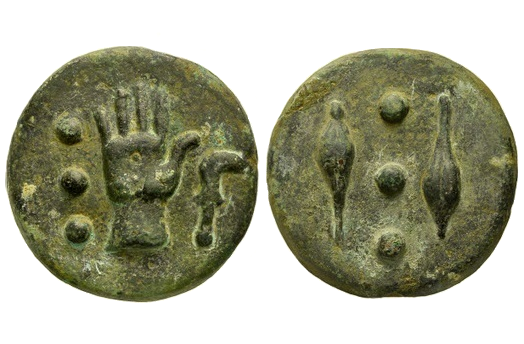
about ancient nomos
Ancient Nomos Art is a museum of galleries exhibiting ancient coins and ancient mint maps. The coin gallery displays the diverse art and history of hand-crafted ancient Greek, Roman, Byzantine, Persian and Medieval coinage. The ancient mints mapping gallery features Greek, Roman, Byzantine, Asia Minor and Medieval mint city regions and territories. Visitor's are welcome to explore, study and enjoy Ancient Nomos Art.

Roman Republic – 240 BC
Cast Quadrans
From Ancient Galleries

Obverse: Manus right hand (military standard) with open palm up and small centering pellet in palmar region.
Reverse: Pair of barley grains têre-bêche with three pellets (mark of value) vertically in field between grains.
LEGEND
Obv: Manus right hand with open palm up, small centering pellet in palmar region; • • • (mark of value) to the left, Falx sword (sickle sword) in field to the right. Rev: Pair of barley grains têre-bêche; • • • (mark of value) vertically in field between grains.
The ancient Roman cast quadrans coin above represents two important and significant additions to early bronze “aes grave” issues from the mint of Rome. Firstly, the coin represents a reduced As denomination in value, and secondly, the coin displays a symbolic representation of the Manus Deior or Manus Domini. As a very early As cast denomination issue, the quadrans coin above is an excellent example of the Rome mint value reduction of the “aes grave” (heavy bronze) coinage. All sub-denominations of the As were based on the Roman libral weight standard unit (originally 1 Roman pound equaled about 324 grams). This standard libral unit was thus subdivided into 12 Roman “unciae” or ounces (see bronze Unciae). The design engravings used a raised dot to denote the coins denomination, as each unciae in weight was represented by one raised dot. This marking system was retained for all Roman cast coinage as well as into the struck bronze coinage issues. The cast bronze coin above is valued as a quadrans (1/4) of an As (literally meaning “a quarter”) or teruncius (“three unciae”) and four quadrans were intrinsically valued as equal to an As (see Apollo As coin). Specifically, the quadrans coinage above is denoted by the three raised pellets ( • • • ) in the fields on both the obverse side and reverse sides of the coin. In addition to three small value pellets, the quadrans obverse also depicts a large centered open-hand, likely symbolic of the Manus Domini atop military standards, as well as a falx sword symbol placed in the field to the right. During the Republican era, army legions always posted and displayed their Manus standards, bearing the symbols significant to the legion, including an open hand Manus Domini. A prominent open hand atop the Manus symbolized the Soldiers devotion and loyalty to the aquila (eagle) and the vexillum (flag), icons that were unique to each Century of the Roman army. The open hand itself also carried meaning, as it represented the oath taken by soldiers declaring their unflagging loyalty to the Republic and upholding its ideals. In addition, the ancient Roman (pre-Christian) Manus Deior or Manus Domini, the Hand of God in Latin, also referred to a Dextera Dei or Dextera Domini, the Right Hand of God. It is very likely the Romans also considered an iconographic gesture of blessing symbol by the Gods, well before it became a Christian symbol. Unlike the open hand depicted in Christian art, the Roman Artist/Engraver had no trouble terminating the open hand just before the forearm. The open hand was a common icon, especially when viewed atop the Manus standard with legionary emblems providing the base or termination to visually conceal the appearance of an appendage as amputated. A small falx sword (sickle sword) symbol appears to the right of the open hand. The single-handed falx sword likely references the Roman soldier’s weapon, but it may perhaps reference an image inspired by ancient agricultural sickle swords. The falx and sickle swords were designed with a curved blade that was sharp on the inside edge and was used by both ancient Greeks and Romans. The quadrans reverse repeats the three small value pellets, but also depicts two large opposing barley grains. These two grain images likely also represent an ancient value unit of measure associated with the very important republican Roman grain trade. The Roman republican expansion and growth during the 3rd century BC was concerned with a large and plentiful supply of several types of grains, including barley, in order to sustain the growing and expanding republic. Unlike other coins during the Roman Empire, the quadrans denomination rarely bore the image of the emperor.
DOCUMENTATION
Value: Quadrans. Metal: Æ Bronze, “Aes Grave.” Weight: 70.00 grams (Libral standard). Mint: Rome. Date: 240 BC.
Attribution: Crawford 25/7; Italian Cast Coinage 51; Thurlow & Vecchi 39; Haeberlin plate 31, 11-12; HN Italy 303; Sydenham 47 = Sydenham, Aes Grave 52; F. Berger, Kestner Museum, Hannover; British Museum, CRR Rome (Aes Grave), London 1910; RBW 44.
Legend, Documentation and Attribution
